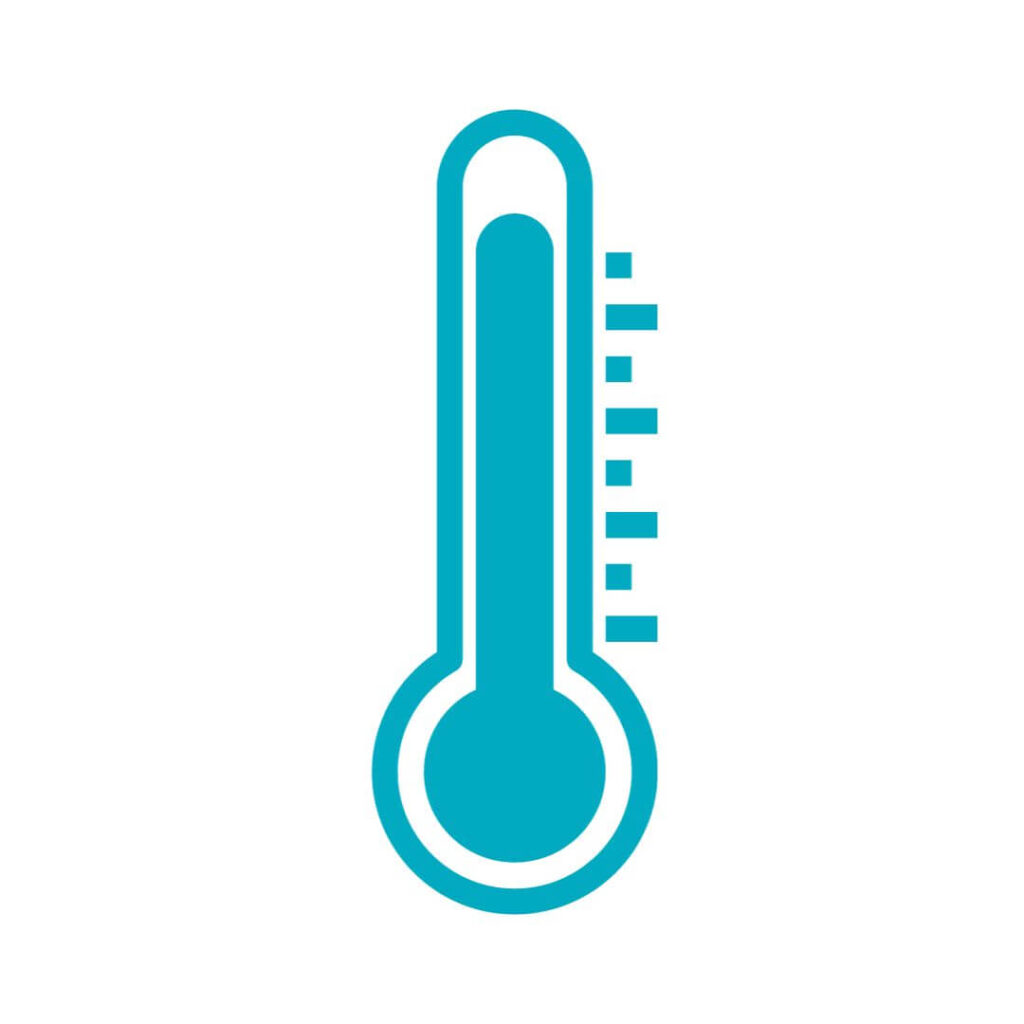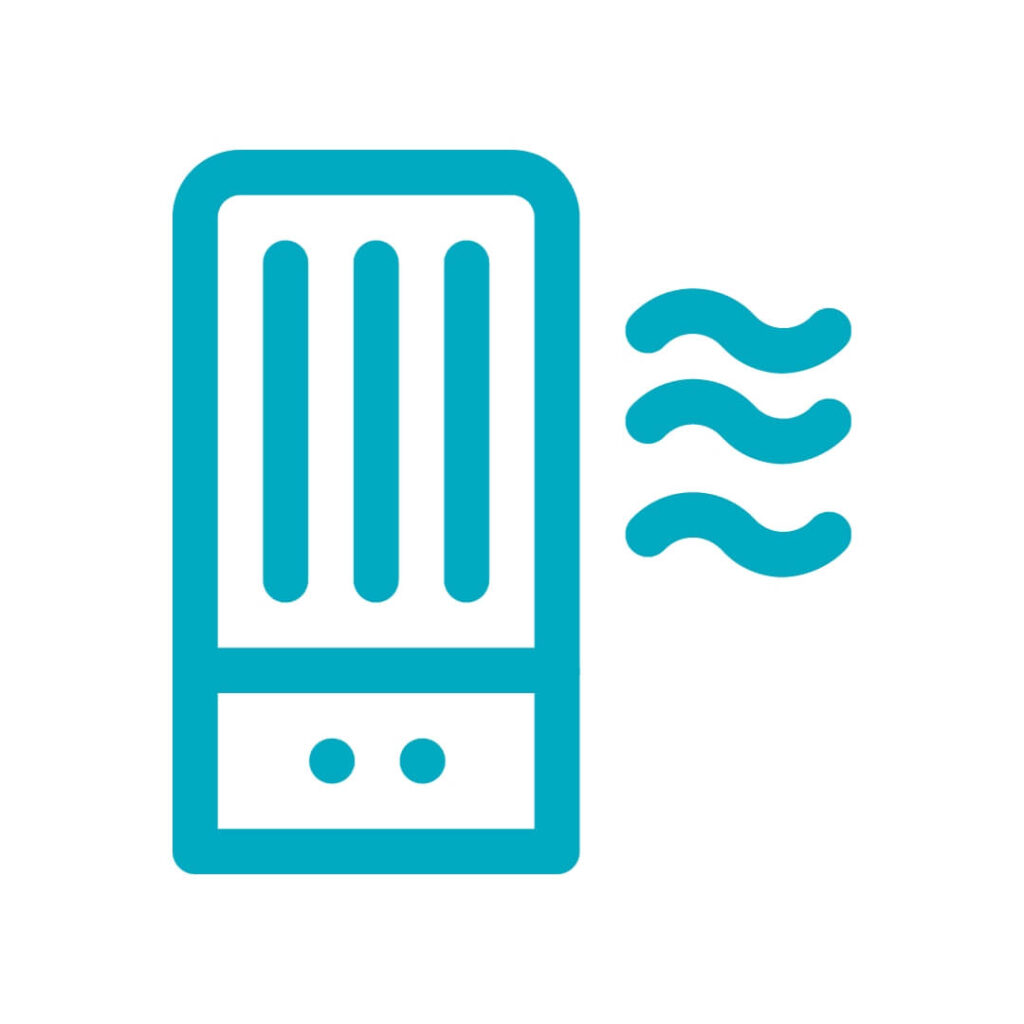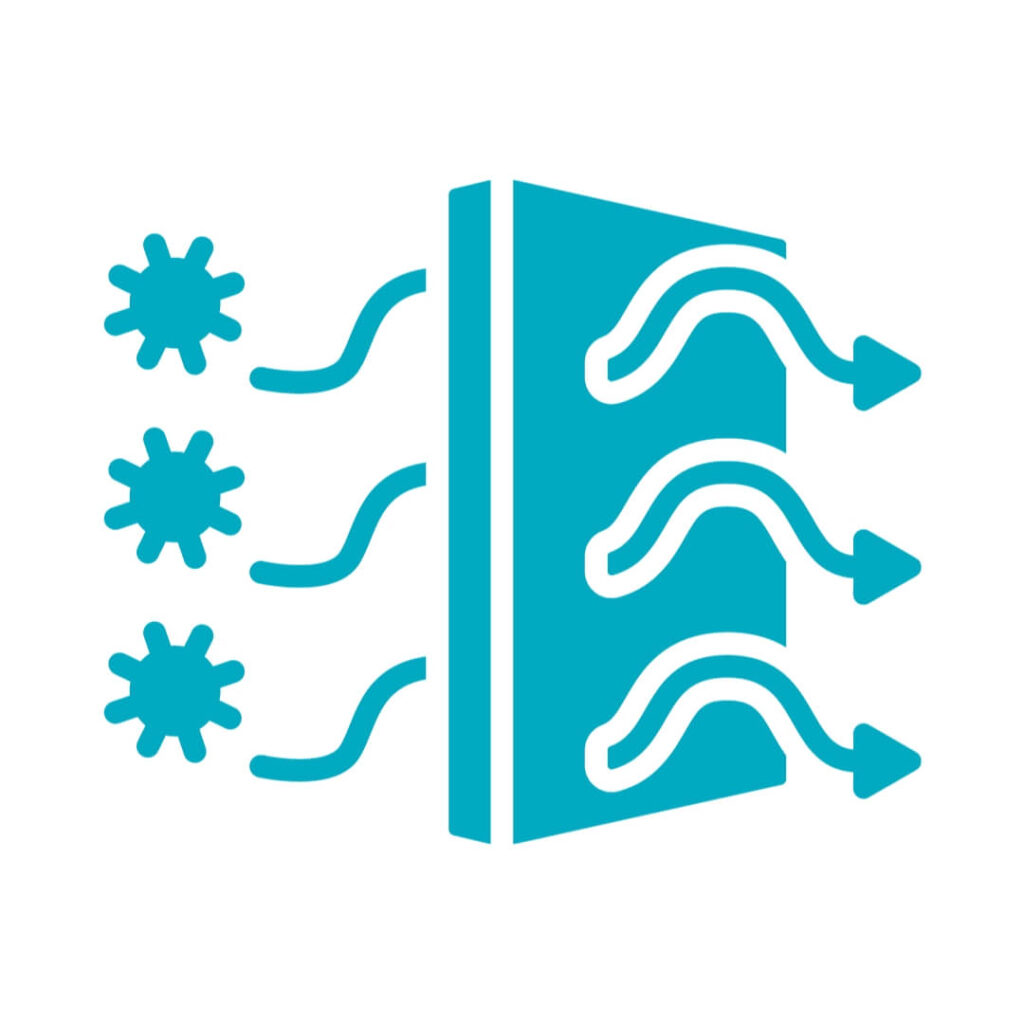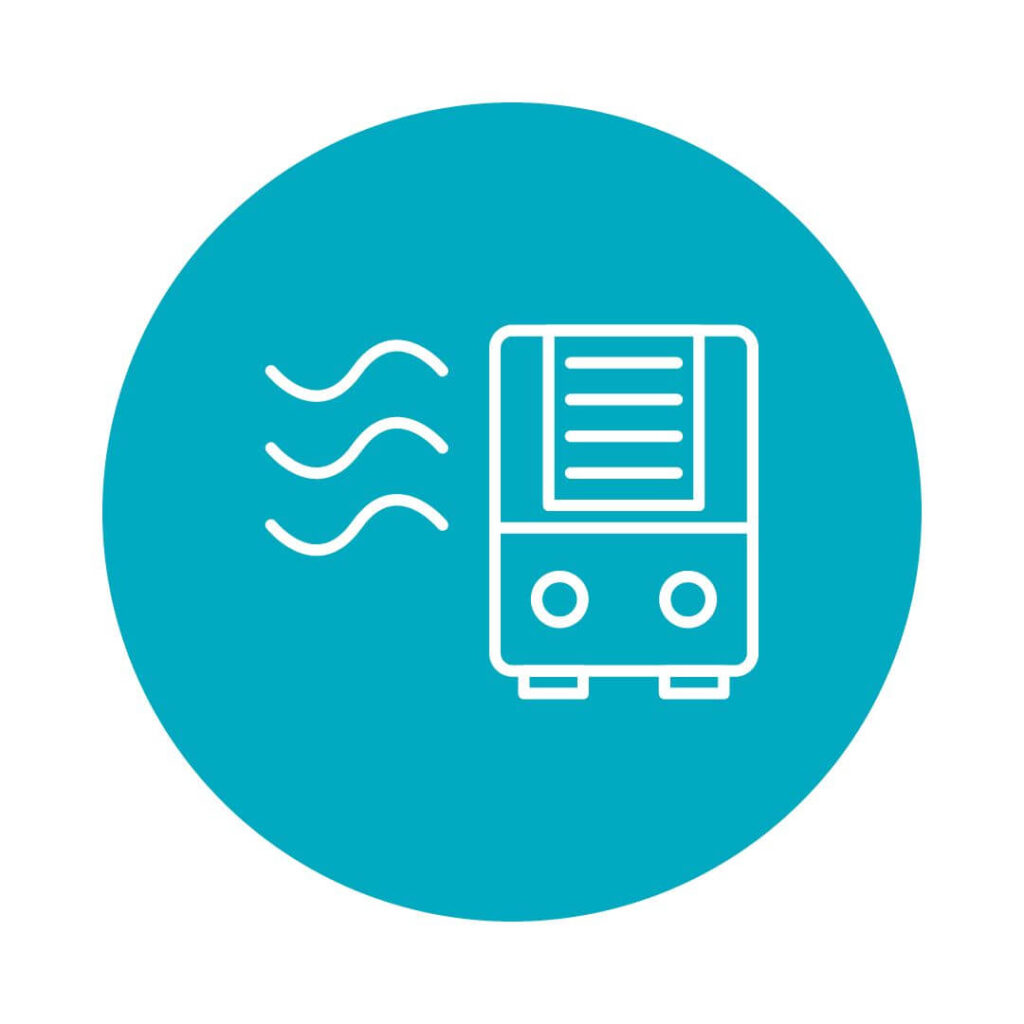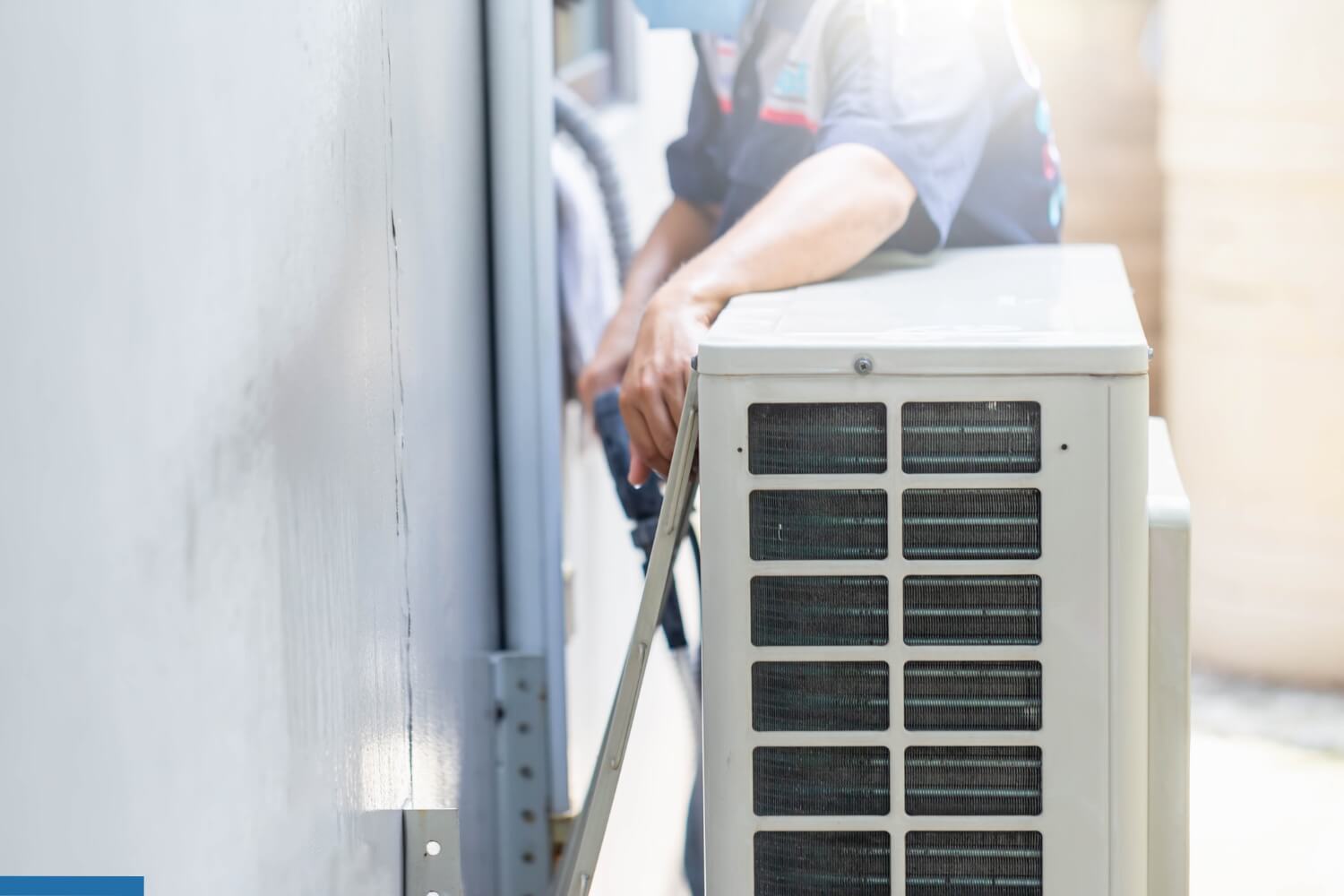
SERVICING: CALGARY & THE CMR
GOODMAN FURNACE & AC REPAIR
Searching for a Goodman furnace and air conditioner repair or installation services in Calgary? One Stop HVAC offers 24/7 repair services for all Goodman products. Call us today to book your appointment!
Same / Next Day
Service 24/7
Rating 5/5
Google Reviews
Licensed TSSA
Technicians
Served Over 1000
Local Residents
Get Your Free
Estimate Today
Great Prices
Guaranteed
GOODMAN HVAC SERVICES
Please Select One Of The Following:
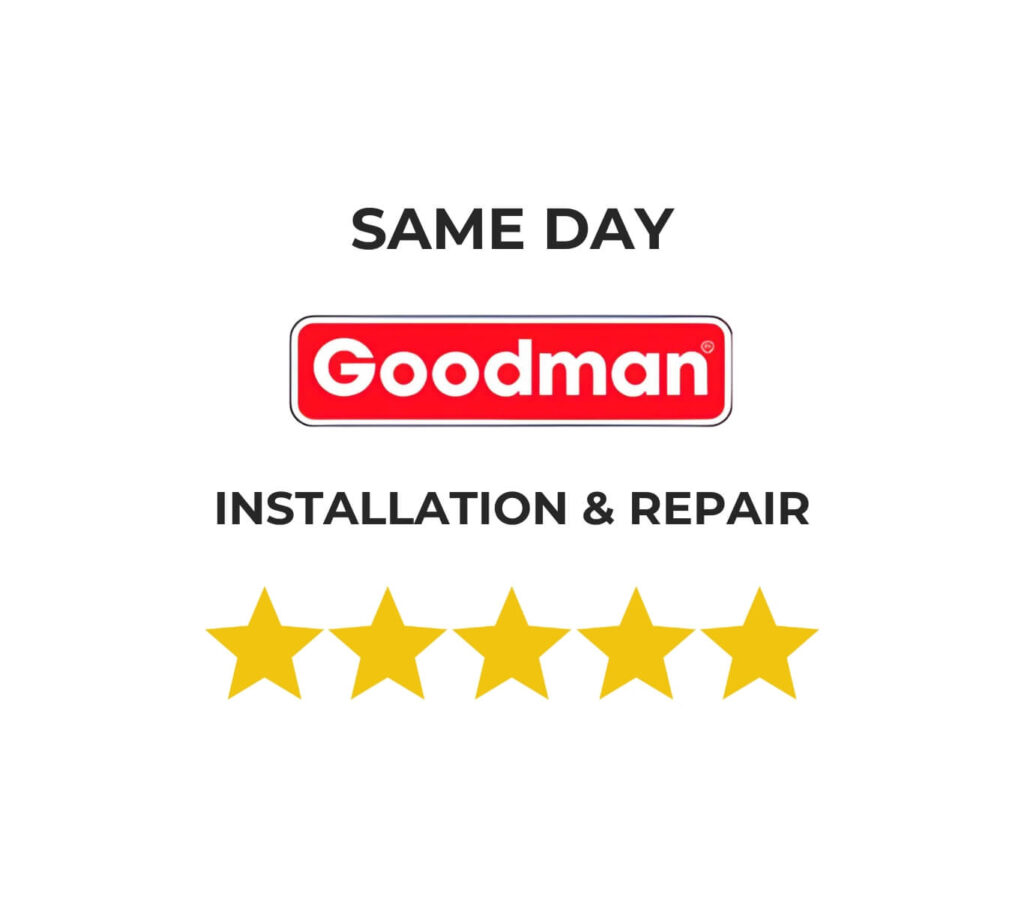
Quick Emergency Goodman Furnace Repair
The one thing you certainly don’t want during the winter months is a malfunctioning furnace. As temperatures drop, a cozy and well-heated home becomes extremely important. Trust our highly-rated Goodman furnace repair and installation services in Calgary for quick and effective solutions to meet all your heating requirements.
One Stop HVAC is committed to providing our clients with the best service by having skilled and experienced technicians. We are here to help, whether you are in need of a routine maintenance check, a repair, or a new Goodman furnace installation. You can rely on us to guarantee a warm and snug home throughout the winter season.
There could be several reasons why your Goodman furnace won’t turn on. Here are some common troubleshooting steps you can take:
- Check the Thermostat:
Ensure that the thermostat is set to a temperature higher than the current room temperature. - Power Supply:
Check the circuit breaker to make sure it hasn’t tripped. If it has, reset it. - Pilot Light or Ignition System:
If your Goodman furnace has a pilot light, ensure that it is lit. For newer models with electronic ignition, check for error codes on the control panel. - Air Filter:
A clogged air filter can restrict airflow, causing the furnace to overheat and shut down. - Gas Supply:
Ensure that the gas supply to the furnace is open. - Thermocouple Issues:
If the thermocouple is faulty, the furnace may not stay lit. - Blower Motor:
Check if the blower motor is running. - Safety Switch:
Furnaces have safety switches that can prevent operation if doors or panels are not securely closed. Make sure all access panels are properly in place.
If your Goodman furnace is blowing cold air, there are several potential issues that could be causing this problem:
- Thermostat Setting:
Ensure that the thermostat is set to the desired temperature. - Pilot Light or Ignition Issues:
Check if the pilot light is lit. For models with electronic ignition, look for error codes on the control panel. - Clogged Air Filter:
A dirty or clogged air filter can restrict airflow. Replace the air filter if needed. - Thermocouple Problems:
If the thermocouple is faulty, the furnace may shut off the gas supply, leading to cold air. - Malfunctioning Gas Valve:
A malfunctioning gas valve may not be allowing sufficient gas flow, resulting in cold air blowing through the system. - Faulty Limit Switch:
If the limit switch malfunctions, it might shut off the burner prematurely, causing cold air circulation. - Issues with the Blower Motor:
Problems with the blower motor or its components can lead to inadequate warm air circulation. - Ductwork Problems:
Leaks or blockages in the ductwork can lead to heat loss, resulting in the delivery of cold air.
Unusual noises are often indicators of underlying issues.
Possible Causes:
- Insecure Blower Motor: If it’s loose, it can produce disruptive sounds during operation.
- Damaged Belts: Replace or tighten them as necessary.
- Worn-out Bearings: It is advisable to seek professional attention for bearing inspection and replacement.
Important: Ignoring these noises may lead to more significant problems and potential breakdowns.
For a thorough inspection and resolution of the noise issue, it is recommended to contact a professional HVAC technician. Our team at One Stop HVAC is ready to assist you!
There could be several factors contributing to weak airflow from your Goodman furnace. Here are some steps you can take to improve airflow:
- Check and Replace Air Filter:
Regularly replace a dirty air filter to prevent significant airflow restrictions. - Inspect Vents and Registers:
Ensure open and unblocked vents and registers for improved airflow. - Examine Ductwork:
Inspect for leaks or blockages in the ductwork and clear obstructions. - Adjust Blower Motor Speed:
Consult the manual to adjust the blower motor speed for optimized airflow. - Ensure Proper Insulation:
Well-insulated homes maintain consistent temperature and airflow. - Check Return Air Duct:
Ensure a clear return air path by removing obstructions. - Inspect Blower Wheel:
Clean the blower wheel to prevent dirt accumulation and damage. - Verify Ductwork Size:
Ensure ductwork size is appropriate for the furnace to prevent reduced airflow. - Professional Inspection:
If issues persist, seek professional HVAC technician assistance for a comprehensive inspection.
Absolutely! You can perform regular maintenance on your Goodman furnace to help prevent major problems and ensure efficient operation. Here are some maintenance tasks you can typically handle:
- Change Air Filters:
Regularly replace air filters to maintain smooth airflow. - Clean Vents and Registers:
Keep vents and registers clean for optimal airflow. - Check Thermostat:
Ensure the thermostat is properly set and has functional batteries. - Inspect Ductwork:
Look for and seal any leaks in the ducts. - Keep Furnace Area Clean:
Clear the space around the Goodman furnace for safety and proper ventilation. - Inspect Flame Sensor:
If applicable, check and clean the flame sensor for proper ignition. - Lubricate Moving Parts:
If needed, lubricate moving parts following the manufacturer’s recommendations.
Remember, for more complex tasks, it’s advisable to schedule professional maintenance annually. Regular upkeep not only prevents issues but also improves efficiency. Always refer to your furnace manual and seek professional help from us if needed.
Dependable Goodman AC Repair & Installation Services
We’re well aware of how hot Canadian summers can get, which is why it is crucial to have a working AC unit. One Stop HVAC offers tailored solutions to meet your specific requirements. Whether you require installation of a new Goodman AC unit or repairs for your existing one, we’ve got you covered.
Reliable and effective maintenance and repairs are crucial for maximizing performance and extending the lifespan of your Goodman AC unit. Overlooking minor issues can escalate into more significant problems, resulting in inconvenience, discomfort, and potentially costly repairs.

Possible reasons for inadequate cooling from your Goodman AC:
- Dirty or Clogged Air Filter:
Replace or clean the air filter regularly to ensure proper airflow. - Refrigerant Issues:
Consult with us to address low refrigerant levels or leaks. - Faulty Capacitor or Compressor:
Have a technician inspect and repair or replace these components if necessary. - Dirty Coils:
Schedule professional cleaning for the evaporator and condenser coils. - Ductwork Problems:
Inspect and repair leaks, blockages, or poorly insulated ductwork. - Insufficient Insulation:
Ensure your home is well-insulated to prevent heat gain. - Incorrect Unit Size:
Consult with a professional to determine if your AC unit size is appropriate. - Excessive Heat Load:
Manage heat sources and consider upgrading your AC if needed.
Here are common reasons for water leakage and possible solutions:
- Clogged or Disconnected Drain Line:
Ensure the drain line is clear, and there are no blockages. - Dirty or Clogged Air Filter:
Replace or clean the air filter regularly. - Frozen Evaporator Coil:
Check for airflow issues, low refrigerant levels, or dirty coils, and address them promptly. - Improper Installation:
Ensure the unit is installed correctly and is levelled. - Cracked or Damaged Drain Pan:
A cracked or damaged drain pan may allow water to leak. Inspect the drain pan and replace it if necessary. - Refrigerant Issues:
Low refrigerant levels can cause the evaporator coil to freeze and lead to water leakage. - Professional Inspection:
If you’re unable to identify the cause or the issue persists, it’s advisable to seek the expertise from us for a thorough inspection and solution.
Regular maintenance, such as keeping the air filter clean and ensuring proper drainage, can help prevent water leakage from your Goodman air conditioner. If you notice persistent or excessive leakage, it’s essential to address the issue promptly to avoid potential damage to your unit and surrounding areas.
If your Goodman AC has a bad smell when running, here are some solutions:
- Dirty Air Filters: Change the filter regularly.
- Mould or Mildew: Clean coils, drain pan, and line. Use mould inhibitors.
- Clogged Drain Line: Clear any blockages in the drain line.
- Dirty Coils: Schedule pro maintenance to clean coils.
- Pests or Animals: If there’s a persistent bad smell, get a professional to check for unwanted visitors.
- Burning Smell: If it smells like burning, turn off the AC and call a professional for inspection.
- Gas Leak: If you smell gas, evacuate and contact emergency services.
If the smell continues or you’re unsure, give us a call. Regular pro maintenance helps prevent such issues.
Here are some possible causes and recommended solutions:
Rattling Noises: Check for any loose screws or panels. If the problem persists, turn off the AC and seek professional assistance promptly to prevent further damage.
Grinding Sounds: Immediately turn off the AC to prevent additional damage and contact a professional technician for a thorough inspection and necessary repairs.
Important: Address unusual noises promptly to prevent potential damage and ensure the efficient operation of your Goodman AC.
If you’re experiencing strange noises from your AC unit, our skilled technicians at One Stop HVAC are prepared to conduct a comprehensive inspection, identify the source of the problem, and carry out the needed repairs. Reach out to us for quick and reliable services to restore the quiet and effective operation of your Goodman AC.
If your Goodman AC is not turning on:
- Check Thermostat Settings:
Ensure the thermostat is set to the desired temperature and mode (cooling). Replace batteries if needed. - Power Supply:
Verify the power supply by checking the circuit breaker and ensuring the disconnect switch is ON. - Faulty Capacitor:
Consult a technician to inspect and replace the capacitor if it’s faulty. - Safety Switch and Panels:
Confirm that all access panels are securely closed to avoid tripping safety switches. - Thermal Overload:
Allow the AC to cool if a thermal overload switch has tripped. Check for issues causing overheating, such as a dirty filter. - Professional Inspection:
If issues persist, contact us for a comprehensive diagnosis and resolution.
Heat Pumps, Thermostats and More
Goodman Heat Pump Repair & Installation
Goodman heat pumps combine heating and cooling functions in one unit, delivering year-round comfort. While these units are valuable for Canadian homes, a malfunction can leave you without an HVAC system. That’s why One Stop HVAC offers 24/7 emergency repairs for Goodman heat pumps and same-day appointments for Goodman heat pump installations. We strive to be your dependable partner, ensuring your home always has a working HVAC system.
If your Goodman heat pump won’t turn on, there could be several factors causing the issue. Here are some common reasons and possible solutions:
- Check Power Supply: Make sure the circuit breaker and disconnect switch are on.
- Verify Thermostat: Confirm the thermostat is set correctly and has working batteries.
- Emergency Shut-Off Switch: Ensure it’s in the “on” position.
- Clean or Replace Air Filters: Dirty filters can hinder operation.
- Refrigerant Levels: Consult a professional for a check and recharge if needed.
- Check Capacitor and Contactor: These parts may need inspection or replacement.
- Inspect Thermostat: A faulty thermostat may not signal the heat pump. Consider replacement.
- Tripped High-Pressure Switch: Have a technician inspect and reset if needed.
If the issue persists, call us for further assistance.
If your Goodman heat pump is not heating or cooling, there could be several issues causing the problem. Here are some potential solutions:
- Thermostat Settings: Check that the thermostat is set to the desired temperature and the correct mode (heat or cool).
- Clogged Air Filters: Dirty filters can restrict airflow. Clean or replace the filters according to the manufacturer’s recommendations.
- Refrigerant Issues: Low refrigerant levels can affect heating or cooling. Consult a professional for a check and recharge if needed.
- Faulty Thermostat: If the thermostat is malfunctioning, it may not send the right signals. Consider having a technician check and replace the thermostat if necessary.
- Defective Capacitor or Contactor: A faulty capacitor or contactor can affect the heat pump’s operation. Consult with a professional for inspection and potential replacement.
- Emergency Shut-Off Switch: Ensure the emergency shut-off switch is in the “on” position.
- Tripped High-Pressure Switch: This safety feature may trip in case of issues. Have a technician inspect and reset if needed.
If you’ve checked these factors and the heat pump is still not heating or cooling, it’s recommended to contact us for a thorough inspection and necessary repairs. We can identify and address specific issues affecting your Goodman heat pump’s performance.
Here are simplified steps to address if your Goodman heat pump has ice build-up:
- Turn Off the Heat Pump: Switch off the heat pump to prevent further ice accumulation.
- Check Air Filters: Inspect and replace dirty air filters, as clogged filters can lead to reduced airflow and ice formation.
- Thaw the Ice: Allow the ice to melt naturally. Do not attempt to chip away the ice, as it can damage the coils.
- Inspect Refrigerant Levels: Low refrigerant levels can contribute to ice build-up. Consult with a professional technician to check for leaks and recharge the refrigerant if needed.
- Clear Obstructions: Ensure there are no obstructions around the outdoor unit that may impede airflow.
- Check Thermostat Settings: Confirm that the thermostat is set correctly for heating mode.
- Inspect Defrost Control: If equipped, check the defrost control to ensure it is functioning properly.
- Schedule Professional Inspection: If the issue persists or recurs, contact a qualified HVAC technician for a thorough inspection and necessary repairs.
Remember, chipping away ice or using sharp objects can cause damage to the heat pumps. It’s essential to allow the ice to melt naturally and address the underlying causes to prevent future ice build-up. Regular maintenance by us can help prevent issues like this and keep your Goodman heat pump operating correctly.
Strange noises from your Goodman heat pump could indicate various issues. Here are some potential causes and solutions:
- Rattling or Vibrating: Loose parts or panels. Tighten any loose components and panels.
- Hissing or Whistling: Air leaks clogged filter, or refrigerant issues. Seal air leaks, replace or clean filters, and consult a professional for refrigerant checks.
- Clicking or Ticking: Electrical issues, such as a faulty thermostat or relay switch. Have a professional technician inspect and repair electrical components.
- Squealing or Screeching: Belt issues, like wear or misalignment. Inspect and replace the belt if necessary.
- Buzzing: Loose parts, electrical issues, or condenser coil problems. Tighten loose parts, inspect electrical components, and schedule maintenance for the condenser coil.
- Thumping or Clanking: Loose or damaged parts. Inspect for loose or damaged parts and have them repaired or replaced.
- Grinding Sounds: Issues with the fan motor or blower assembly. Turn off the heat pump immediately and contact a professional technician for inspection and repairs.
If unusual noises persist or you’re unsure about the cause, it’s best to contact us for a thorough inspection.
Identifying a broken Goodman heat pump compressor may require professional inspection, but you can look for certain signs that may indicate an issue. Here are some things to look out for:
- No Cooling or Heating: If your heat pump is not providing adequate heating or cooling, it could signal compressor problems.
- Unusual Noises: Grinding, clicking, or other unusual noises from the outdoor unit may indicate compressor issues.
- Tripped Circuit Breaker: If the compressor is drawing too much current, it may trip the circuit breaker.
- Hot Outdoor Unit: A compressor working harder than usual may cause the outdoor unit to become excessively hot.
- Uneven Cooling or Heating: If some rooms are not reaching the desired temperature, it could be a compressor issue.
- Hissing Sounds: Refrigerant leaks, often accompanied by hissing sounds, can be a sign of a compressor problem.
If you notice any of these signs, it’s crucial to contact us for a thorough inspection and diagnosis. Attempting to repair or replace a compressor without proper training and equipment can be hazardous and may void warranties.
Goodman Ductless AC Unit Repair & Installation
One Stop HVAC provides dependable Goodman Ductless AC Unit repairs and installations across Calgary and the CMR. Our team of experienced technicians is available 24/7, offering emergency repairs for Goodman ductless AC units and same-day services for ductless AC unit installations. With years of expertise in servicing Goodman products, our team can conduct on-site repairs and create custom installation plans that prioritize your comfort.
Goodman ductless AC units consist of an outdoor condenser unit and indoor air-handling units. The outdoor unit circulates refrigerant, releasing heat outside, while indoor units absorb heat and cool the air. Refrigerant lines connect the units through a conduit. These systems offer individualized comfort with zoning capabilities and may use inverter technology for energy efficiency. Installation is flexible, making Goodman ductless AC units suitable for various spaces.
Ductless AC systems offer several advantages, including:
- Energy Efficiency: Ductless systems allow for zone-based heating and cooling, enabling you to only condition the spaces in use, reducing energy waste.
- Installation Flexibility: Since ductless systems don’t require ductwork, they are easier to install and are suitable for both new construction and retrofitting existing homes.
- Customizable Zoning: Each indoor unit can be controlled independently, allowing for personalized temperature settings in different rooms or zones.
- Improved Indoor Air Quality: Ductless units typically come with advanced filtration systems, enhancing indoor air quality by reducing dust, allergens, and pollutants.
- Compact Design: The indoor units are sleek and compact, providing more flexibility in terms of placement and aesthetics.
- Cost Savings: Energy-efficient operation and the ability to control individual zones can lead to lower utility bills compared to traditional central air conditioning systems.
Proper maintenance is essential for the best performance of a ductless AC system. Here are some steps:
- Cleaning Filters: Regularly clean or replace air filters, typically every few weeks or according to the manufacturer’s recommendations, to ensure proper airflow and efficiency.
- Outdoor Unit Maintenance: Keep the outdoor unit clear of debris, leaves, and other obstructions. Periodically check for any dirt or buildup on the condenser coils and clean them as needed.
- Indoor Unit Cleaning: Wipe down the indoor unit with a damp cloth to remove dust. Take care not to block the airflow by placing objects near the unit.
- Condensate Drain Inspection: Ensure the condensate drain line is not clogged. If needed, use a mixture of water and bleach to clear any blockages.
- Professional Check-ups: Schedule annual maintenance by us. We can perform a thorough inspection, check refrigerant levels, and address any potential issues.
Regular maintenance not only improves the efficiency of your ductless AC unit but also extends its lifespan and helps maintain good indoor air quality.
The lifespan of a ductless AC unit can vary based on many factors such as usage, maintenance, and the quality of the unit. On average, a well-maintained ductless AC system can last between 12 to 20 years. Regular maintenance, including cleaning filters, checking refrigerant levels, and scheduling professional inspections, can contribute to the longevity of the unit. It’s important to follow Goodman’s recommended maintenance guidelines and promptly address any issues to ensure optimal performance and more extended operational life for your ductless AC system.
Absolutely, Goodman ductless AC units are suitable for both residential and commercial applications. Their flexibility in zoning and installation makes them ideal for various settings. In homes, ductless systems are commonly used for room additions, converted spaces, or as the primary cooling and heating solution. In commercial settings, they are employed in offices, retail spaces, server rooms, and other areas where individualized climate control and energy efficiency are priorities. The ability to cool or heat specific zones independently makes ductless systems a practical and efficient choice for a wide range of applications.
Goodman HEPA Filter Repair & Installation
Goodman HEPA filters are made to collect microscopic particles, including dust, allergens, and contaminants. These filters are crafted with advanced technology to ensure the best performance, trapping particles as small as 0.3 microns. Whether integrated into residential HVAC systems or commercial air purification units, Goodman’s HEPA filters contribute to a healthier and cleaner indoor environment by removing particles in the air and promoting a more comfortable and breathable space for people. Call One Stop HVAC to get your Goodman HEPA filter installed or repaired today!
A Goodman HEPA (High Efficiency Particulate Air) filter is a specific type of air filter crafted to capture and retain a high percentage of extremely small particles found in the air. HEPA filters exhibit remarkable efficiency, capable of trapping particles as tiny as 0.3 microns with a rating of at least 99.97%. These filters find widespread use in air purifiers, vacuum cleaners, and HVAC systems to enhance indoor air quality by eliminating allergens, dust, pollen, mould spores, and other airborne particles. The intricate and dense design of Goodman HEPA filters ensures thorough cleansing of the air passing through them, making them especially effective in settings where clean and purified air is vital, such as hospitals, laboratories, and residential spaces.
The frequency of replacing a HEPA filter depends on various factors, including the type of environment, the concentration of airborne particles, and the manufacturer’s recommendations. However, here are some general guidelines:
Residential HVAC Systems: In a typical home HVAC system, it’s often advisable to replace the HEPA filter every 6 to 12 months. However, if you have specific air quality concerns or allergies, you might want to check the filter more frequently.
Air Purifiers: For standalone air purifiers equipped with HEPA filters, the replacement interval can vary. Some filters may require replacement every 6 to 12 months, while others may last up to two years. Refer to the manufacturer’s guidelines for your specific air purifier.
Commercial or Industrial Settings: In environments with elevated levels of airborne particles, such as laboratories or industrial spaces, HEPA filters may require more frequent replacement. Regular monitoring and adherence to the manufacturer’s recommendations are crucial.
Allergies or Respiratory Conditions: If you or your family members have allergies or respiratory conditions, consider replacing the HEPA filter more frequently, perhaps every 3 to 6 months, to maintain optimal air quality.
Always consult the Goodman user manual or guidelines. Additionally, routinely inspect the filter, and if you observe a significant decrease in airflow or a visible accumulation of particles, it may be time for replacement, irrespective of the recommended time frame.
Yes, Goodman HEPA filters are engineered to significantly enhance indoor air quality by capturing and trapping airborne particles, including allergens such as dust mites, pollen, pet dander, and mold spores. The high efficiency of HEPA filters, with a capture rate of at least 99.97% of particles as small as 0.3 microns, makes them effective in reducing allergens that can trigger respiratory issues.
Incorporating a Goodman HEPA filter into your HVAC system can offer relief for individuals with allergies or respiratory conditions by minimizing the presence of airborne irritants. These filters create a cleaner and healthier indoor environment, promoting better respiratory health and reducing the risk of allergy-related symptoms. Regular replacement and maintenance of Goodman HEPA filters ensure their continued effectiveness in providing allergy relief and maintaining optimal indoor air quality.
Yes, Goodman HEPA filters play a pivotal role in enhancing indoor air quality by not only capturing allergens but also mitigating odours. HEPA filters efficiently trap particles, including airborne particles that may carry odours, contributing to a fresher and cleaner indoor environment.
While HEPA filters primarily target particulate matter, they can contribute to a more pleasant living space by capturing particles associated with odours. Additionally, some Goodman HEPA filters may feature additional elements, such as activated carbon layers, specifically designed to adsorb odours and certain gases.
Regularly replacing Goodman HEPA filters and adhering to the manufacturer’s maintenance guidelines will ensure the ongoing effectiveness of the filters in reducing odours and improving indoor air quality.
Goodman HEPA filters offer several key advantages in various indoor environments. Firstly, they significantly enhance indoor air quality by capturing and eliminating a high percentage of airborne particles, including allergens, dust, mold spores, and pollutants. This, in turn, fosters a healthier living or working environment by reducing the potential for respiratory issues and allergies.
Moreover, Goodman HEPA filters can improve overall well-being by establishing a cleaner and more comfortable space. The removal of microscopic particles not only enhances respiratory health but also diminishes the presence of irritants that may cause discomfort.
In settings where individuals with allergies, asthma, or other respiratory conditions reside or work, the use of Goodman HEPA filters is particularly valuable. They provide an effective means of minimizing airborne allergens, contributing to better health outcomes.
Furthermore, Goodman HEPA filters can play a role in preventing the spread of certain airborne diseases and maintaining a more hygienic atmosphere. Regular replacement and proper maintenance of HEPA filters are essential to ensure their ongoing effectiveness in delivering these benefits.
Goodman Thermostat Repair & Installation
Goodman offers a varied selection of thermostats that play a pivotal role in controlling the heating and cooling functions of your home. One Stop HVAC is available 24/7 for emergency repairs on Goodman thermostats. We also provide same-day appointments for installing Goodman thermostats. Our experienced technicians have extensive expertise with Goodman thermostats, allowing them to not only resolve issues but also enhance the performance of your Goodman HVAC system, ensuring efficient heating and cooling in your home.
Several factors could contribute to your Goodman thermostat not turning on. Here are some common reasons and troubleshooting steps:
- Power Issues: Ensure it’s properly connected to the power source, and if it uses batteries, make sure they are not depleted. Replace the batteries if necessary.
- Circuit Breaker: Inspect the circuit breaker connected to your HVAC system. If the breaker is tripped, reset it. A tripped breaker can disrupt power to the thermostat.
- Settings and Programming: Verify that the thermostat is set to the desired temperature and operating mode (cooling or heating). Check the programmed schedule, if applicable, to ensure it aligns with your preferences.
- HVAC System Issues: Check if there are issues with your HVAC system itself. Problems like a malfunctioning furnace or air conditioner could prevent the thermostat from triggering the system.
- Faulty Wiring: Inspect the thermostat wiring to ensure it’s connected correctly. Loose or damaged wires can impede communication between the thermostat and HVAC system.
- Sensor Problems: Some thermostats have temperature sensors that might be malfunctioning. Ensure that the sensor is clean and positioned correctly.
- Thermostat Display: If the thermostat display is blank, it may indicate a power issue or a problem with the thermostat itself. Try resetting the thermostat or replacing batteries.
- Manufacturer’s Manual: Refer to the manufacturer’s manual for specific troubleshooting steps related to your Goodman thermostat model.
If you’ve tried these steps and the issue persists, it may be advisable to seek professional assistance. We can conduct a thorough inspection, identify the root cause, and perform any necessary repairs or replacements.
If your Goodman thermostat isn’t reaching the set temperature:
- Check Settings: Confirm the thermostat is set correctly.
- Airflow and Vents: Ensure vents are unblocked for proper airflow.
- Replace Filters: Dirty filters can hinder system efficiency; replace them.
- Thermostat Location: Avoid direct sunlight or heat sources near the thermostat.
- Calibration: Some thermostats may need calibration for accuracy.
- System Size: Ensure your HVAC system is appropriately sized.
- HVAC Issues: Malfunctioning components may need professional attention.
- Sensor Check: Clean and position the thermostat sensor accurately.
- Programming Review: Check for errors or conflicts in the thermostat schedule.
If issues persist, consult a licensed HVAC technician for a thorough inspection and necessary repairs.
If your room temperature doesn’t match your Goodman thermostat settings:
- Check Thermostat Settings: Confirm the correct temperature and mode.
- Thermostat Location: Ensure it’s away from direct sunlight or drafts.
- Sensor Maintenance: Clean and position the thermostat sensor properly.
- Calibration: Follow the manual instructions for calibration.
- Airflow and Vents: Clear vents and ensure proper airflow.
- Replace Air Filters: Dirty filters can affect system efficiency; replace as needed.
- HVAC System Check: Inspect for malfunctions; consult a professional if necessary.
- System Size: Ensure your HVAC system is appropriately sized for the space.
- Consider External Factors: Weather changes or insulation modifications may impact room temperature.
If issues persist, contact a licensed HVAC technician for a thorough assessment and any required repairs.
If your Goodman thermostat isn’t maintaining a consistent temperature:
- Check Settings: Ensure the thermostat is set correctly with no programming errors.
- Thermostat Location: Place it away from direct sunlight, drafts, and obstructions.
- Sensor Maintenance: Clean the sensor as per the user manual.
- Calibration: Calibrate the thermostat for accurate temperature readings.
- Airflow and Vents: Ensure vents are open and unobstructed for proper airflow.
- Replace Air Filters: Replace dirty filters to maintain system efficiency.
- HVAC System Check: Inspect for malfunctions; consult a professional if needed.
- System Size: Ensure your HVAC system is appropriately sized.
- Consider External Factors: Account for weather changes, insulation, or drafts.
- Smart Thermostat Settings (if applicable): Review and configure smart features accurately.
If issues persist, contact a licensed HVAC professional for a thorough assessment and necessary adjustments.
The process of resetting a Goodman thermostat can vary depending on the model you have. However, here are general steps that might help you reset a typical programmable thermostat:
- Locate the Reset Button: Some thermostats have a dedicated reset button. Look for a small button, often located near the display or on the back of the thermostat.
- Press and Hold the Reset Button: If you find a reset button, use a paperclip or a small tool to press and hold it for about 5-10 seconds. This should initiate the reset process.
- Power Cycle the Thermostat: Another method is to power cycle the thermostat. To do this, turn off the power to your HVAC system by flipping the corresponding circuit breaker or removing the fuse. Wait for about 30 seconds and then turn the power back on.
- Check the User Manual: If you have the user manual for your specific Goodman thermostat model, refer to it for detailed instructions on how to reset the thermostat. The manual usually provides model-specific information and troubleshooting steps.
Remember that playing around with the thermostat settings may affect your HVAC system’s performance, so if you’re unsure or uncomfortable with the process, please give us a call, and we’d be happy to help you!
Goodman UV Air Purifier Repair & Installation
One Stop HVAC proudly offers Goodman UV air purifiers, presenting an advanced solution for enhancing indoor air quality. Goodman UV air purifiers utilize ultraviolet light technology to eradicate airborne contaminants such as bacteria, viruses, and mould. These purifiers elevate the general cleanliness of the air within your home, fostering a healthier living environment. At One Stop HVAC, we provide 24/7 emergency repair services for Goodman UV air purifiers, ensuring prompt assistance when needed. With the convenience of same-day appointments, customers can depend on us for efficient installation and responsive repairs, contributing to a more comfortable and breathable home environment.
Utilizing a Goodman UV air purifier provides various advantages, including the elimination of bacteria, viruses, and mould for enhanced indoor air quality. By diminishing airborne contaminants, these purifiers promote better respiratory health and establish a cleaner living environment. Moreover, they can assist in reducing common household odours and complement other air purification methods, offering a comprehensive solution. Goodman UV air purifiers are designed to be compatible with various HVAC systems, present potential long-term cost savings, and demand convenient maintenance for optimal performance, making them a versatile and effective choice for improving indoor air quality.
While the main purpose of Goodman UV air purifiers is to address and eliminate microorganisms like bacteria, viruses, and mould, they also play a role in minimizing common household odours. The UV technology utilized by these air purifiers aids in neutralizing particles in the air, including molecules that cause odours. Although not explicitly crafted as odour eliminators, Goodman UV air purifiers can positively influence overall indoor air quality, potentially resulting in a decrease in unpleasant odours.
The frequency of UV lamp replacement in your Goodman air purifier depends on the specific model and usage. Generally, UV lamps typically have a lifespan ranging from 9 months to 2 years. It’s crucial to consult the user manual for your specific Goodman air purifier model, as it will provide precise information on the recommended replacement interval for the UV lamp.
Regular maintenance, including timely replacement of the UV lamp, is essential to ensure the continued effectiveness of the air purifier in neutralizing microorganisms. If you’re unsure about the replacement schedule or if your UV lamp needs changing, it’s always advisable to refer to the manufacturer’s guidelines or contact us for assistance.
Goodman UV air purifiers have the capability to effectively decrease pet dander and common airborne allergens. The ultraviolet (UV) light technology incorporated in these air purifiers is specifically engineered to target and neutralize a range of airborne particles, including pet dander—an often encountered allergen. By actively eliminating these particles, Goodman UV air purifiers play a role in establishing a cleaner and healthier indoor environment. This makes them particularly advantageous for individuals with allergies or sensitivities to pet dander and other common allergens.
Goodman offers both regular air purifiers and UV air purifiers, and the primary difference lies in the technology they use for air purification:
Regular Goodman Air Purifiers:
- These typically use filters, such as HEPA (High Efficiency Particulate Air) filters or activated carbon filters, to capture and remove airborne particles like dust, pollen, and pet dander.
- The filtration process helps improve indoor air quality by trapping and removing various contaminants.
- Regular air purifiers are effective for addressing particulate matter but may not be as efficient in neutralizing microorganisms like bacteria and viruses.
Goodman UV Air Purifiers:
- UV air purifiers, on the other hand, utilize ultraviolet (UV) light technology to target and neutralize microorganisms in the air, such as bacteria, viruses, and mould.
- The UV light disrupts the DNA structure of these microorganisms, rendering them unable to reproduce and causing their deactivation.
- UV air purifiers are particularly effective in addressing biological contaminants, making them beneficial for maintaining a cleaner and healthier environment.
While regular Goodman air purifiers focus on removing airborne particles through filtration, Goodman UV air purifiers employ UV light technology to neutralize and deactivate microorganisms. The choice between the two depends on the specific air quality concerns and the types of contaminants you want to address in your indoor environment. Some users may even opt for a combination of both technologies for comprehensive air purification.
Goodman Air Purifier Repair & Installation
The rising popularity of air purifiers in Canada is attributed to the country’s constantly shifting climate, leading to extensive reliance on HVAC systems for indoor comfort. Goodman air purifiers play a vital role in guaranteeing that the air circulated within your home stays pure and devoid of airborne pollutants. Nonetheless, experiencing issues with your Goodman air purifier may result in the spread of impure air throughout your property. One Stop HVAC offers 24/7 emergency repairs for Goodman air purification systems and provides same-day appointments for Goodman air purifier installations. Our adept technicians are dedicated to reinstating your Goodman air purifier to peak functionality!
If your Goodman air purifier won’t turn on, consider the following:
- Power Check: Ensure it’s properly plugged in, the power switch is on, and the outlet is functional.
- Cord Inspection: Examine the power cord for damage; replace if necessary.
- Circuit Breaker: Confirm the circuit breaker isn’t tripped; reset if needed.
- Filter Verification: Ensure filters are correctly installed, as some units may not operate without proper filter placement.
- Timer Settings: Check for any timer settings that might be preventing the unit from turning on.
- Button Functionality: Inspect the control panel and buttons for damage or malfunctions.
- Remote Control: If applicable, check and replace the batteries in the remote control.
- Internal Issues: If all else fails, seek professional assistance for a thorough inspection and potential repairs.
If your Goodman air purifier continues to have issues turning on, and the troubleshooting steps do not resolve the problem, get professional assistance from One Stop HVAC to ensure proper diagnosis and resolution.
If your Goodman air purifier is overheating, several factors could be contributing to the issue. Here are some potential reasons and troubleshooting steps:
- Airflow Obstruction: Check for any obstructions around the air purifier that may be limiting airflow. Ensure there is ample space for proper ventilation.
- Dirty Filters: Overheating can occur if the air filters are clogged with debris. Regularly clean or replace the filters as recommended in the user manual.
- Blocked Vents: Ensure that the vents on the air purifier are not blocked. Blocked vents can impede the intake of air, leading to overheating.
- Operating Environment: Check if the air purifier is placed in an environment with elevated temperatures. Avoid placing it near heat sources that could contribute to overheating.
- Electrical Issues: Verify that the power outlet and cord are in good condition. A damaged cord or faulty outlet can lead to overheating. If the cord is damaged, it may need replacement.
- Internal Components: Internal components, such as the motor or other electrical parts, may be malfunctioning. If the unit continues to overheat, it’s advisable to seek professional assistance for a thorough inspection.
- Excessive Usage: If the air purifier is running continuously for extended periods, it may overheat. Refer to the user manual for recommended usage durations and rest periods.
- Manufacturer Support: If troubleshooting steps do not resolve the issue, contact customer support or the authorized dealer for guidance and potential warranty assistance.
If the problem persists or if you are uncertain about performing the troubleshooting steps, it’s recommended to seek professional help to avoid any potential hazards.
If your Goodman air purifier controls stop working, try these troubleshooting solutions:
- Power Supply Check: Check the power cord, and outlet, and ensure the unit is properly plugged in.
- Control Panel Lock: Check for a control panel lock feature in the user manual and follow instructions to unlock the controls if necessary.
- Remote Control Batteries: If applicable, inspect and replace the batteries in the remote control.
- Electronic Malfunction and Reset: Unplug the air purifier, wait a few minutes, and then plug it back in to reset the system. This may resolve electronic malfunctions.
If the issue persists after addressing these points, consider seeking professional assistance or contacting Goodman customer support for further guidance.
If you are experiencing strange noises from your Goodman air purifier while it’s running, it could be indicative of various issues. Here are some potential reasons and troubleshooting steps:
- Loose Parts: Check for any loose or improperly installed parts, including filters, panels, or internal components. Securely fasten or reposition any loose elements.
- Fan Issues: Inspect the fan blades for obstructions, such as debris or dust, and clean if necessary. If the noise persists, there may be an issue with the fan motor that requires professional attention.
- Airflow Obstruction: Ensure there are no obstructions blocking the airflow in or out of the air purifier.
- Vibrations: Place the air purifier on a level and stable surface. Vibrations from an uneven surface can result in noise. If applicable, check if any vibration-dampening features are in place and functioning.
- Filter Issues: Dirty or clogged filters can cause the system to work harder, resulting in unusual sounds. Clean or replace the filters following the manufacturer’s recommendations.
- Electronic Malfunctions: Electronic components, such as the control board or sensors, may be malfunctioning. If basic troubleshooting doesn’t resolve the issue, professional assistance may be necessary.
- Humidity Levels: Ensure that the unit is operating within the recommended humidity range.
- Internal Motor Issues: If the noise persists and is not resolved by basic troubleshooting, seek professional assistance for a more in-depth inspection.
If you are unable to identify or address the cause of the strange noises, it’s recommended to contact us for further assistance.
Troubleshooting Steps:
- Ventilation and Odor Source: If you detect an unfamiliar scent, enhance ventilation by opening doors and windows for about an hour. Keep them closed while running the Goodman air purifier.
- Kitchen Ventilation: Improve kitchen ventilation by installing a vent or exhaust system. This helps eliminate cooking odors, preventing them from affecting the efficiency of the Goodman air purifier.
- Deodorizing Air Filter: Some Goodman air purifiers use deodorizing air filters with materials like activated carbon, which might initially produce a temporary unusual odor.
If your Goodman air purifier continues emitting an odd scent despite these troubleshooting measures, professional assistance may be necessary to pinpoint and address the issue effectively. Contact One Stop HVAC for expert guidance and support.
Goodman Humidifier Repair & Installation
One Stop HVAC offers professional repair and installation services for Goodman humidifiers. Leveraging our team’s extensive expertise, we specialize in conducting thorough on-site repairs and crafting personalized installation plans tailored to your specific requirements for Goodman humidifiers. Our services provide 24/7 emergency repairs and same-day appointments, ensuring you consistently have access to dependable humidifier solutions.
Several factors could be contributing to your Goodman humidifier not turning on. Here are some common reasons and troubleshooting steps:
Power Supply: Ensure the humidifier is securely plugged into a functional power outlet, and check the power cord for any damage.
Humidistat Settings: Verify that the humidistat is set to the desired humidity level. Ensure the current humidity level in the room is below the set level.
Water Supply: Check the water supply to the humidifier, ensuring the water reservoir is filled, and the water inlet is not blocked.
Dirty or Clogged Components: Inspect the humidifier for dirty or clogged components, including the water reservoir, water distribution system, or evaporator pad. Clean or replace these parts as needed.
Addressing these key points can often resolve common issues preventing a Goodman humidifier from turning on. If problems persist, consider seeking assistance from One Stop HVAC for a more thorough inspection and resolution.
If the drum in your Goodman humidifier is not turning, there could be several factors causing the issue. Here are some common reasons and troubleshooting steps:
- Obstruction or Jam: Clear any debris, such as mineral deposits or foreign objects, that could be causing a jam.
- Motor Issues: If the motor is malfunctioning or has burned out, it may need to be repaired or replaced.
- Drive Belt: Some humidifiers use a drive belt to connect the motor to the drum. Check if the drive belt is intact and properly positioned. A loose or broken belt may need replacement.
- Lubrication: Lack of lubrication can cause friction and resistance, preventing the drum from turning smoothly. Lubricate the moving parts as per the manufacturer’s recommendations.
- Drum Alignment: Misalignment can lead to operational issues. Adjust the drum if needed, following the manufacturer’s instructions.
- Humidifier Settings: Check the humidistat settings to ensure they are appropriate for the desired humidity level. If the humidistat is set too high, it may cause the drum to strain or overwork.
- Power Supply: Verify that the humidifier is properly plugged in and receiving power. Check the power cord and the outlet for any issues.
By systematically checking these potential issues, you can identify and address the cause of the drum in your Goodman humidifier not turning. If problems persist, seeking professional help is recommended.
If your Goodman humidifier is overflowing, there could be several reasons for this issue. Here are some common causes and troubleshooting steps:
Water Supply Issue:
- Check the water supply to the humidifier. Ensure that the water line is properly connected and not clogged.
- Verify that the water valve supplying water to the humidifier is fully open.
Float Valve Malfunction:
- Many humidifiers have a float valve that regulates water levels. If the float valve is stuck or not functioning correctly, it can lead to overfilling.
- Inspect the float valve for any obstructions or damage. Clean or replace it if necessary.
Water Panel or Evaporator Pad Issues:
- A clogged or dirty water panel or evaporator pad can impede proper water absorption and lead to overflow.
- Regularly clean or replace the water panel according to the manufacturer’s recommendations.
Humidistat Calibration:
- The humidistat controls the humidity level. If it’s not calibrated correctly, the humidifier may overwork and overflow.
- Adjust the humidistat to the desired humidity level. Refer to the user manual for calibration instructions.
Drain Line Blockage:
- Check the drain line for any blockages. A clogged drain line can prevent proper water drainage, leading to overflow.
- Clear any debris or buildup in the drain line.
Water Inlet Valve:
- The water inlet valve controls the flow of water into the humidifier. If it’s malfunctioning, it may cause overfilling.
- Inspect the water inlet valve for proper functioning. Replace it if necessary.
If you’ve checked these common issues and the problem persists, it’s advisable to seek professional assistance. A qualified technician can perform a thorough inspection and address any underlying issues with your Goodman humidifier.
If your Goodman humidifier is experiencing drainage issues, several factors could be contributing to the problem. Here are common reasons and troubleshooting steps:
Clogged Drain Tube:
- Examine the drain tube for any obstructions or blockages. Debris, mineral deposits, or mould growth can impede proper drainage. Clean the drain tube thoroughly.
Improper Slope:
- Ensure that the humidifier is installed with a slight slope towards the drain. This facilitates proper water flow and prevents standing water.
Faulty Drain Valve:
- The drain valve controls the release of water from the humidifier. If it’s stuck or not functioning correctly, it can hinder drainage. Inspect the drain valve and replace if necessary.
Drain Line Installation:
- Confirm that the drain line is properly installed and not kinked or twisted. A kinked line can restrict water flow and cause drainage issues.
Reservoir Overfilling:
- If the water inlet valve or water float is malfunctioning, the reservoir may overfill, leading to drainage problems. Address issues with the water inlet valve and water float.
Clogged Evaporator Pad or Drum:
- If the evaporator pad or drum is clogged with mineral deposits or debris, it can affect water distribution and drainage. Clean or replace these components as needed.
Humidistat Calibration:
- The humidistat controls the humidity level. If it’s not calibrated correctly, it may cause the humidifier to overfill, impacting drainage. Consult the user manual for instructions on calibrating the humidistat.
Air Lock:
- An air lock in the drain line can impede water flow. Try gently shaking or tapping the drain line to release any trapped air.
High Water Pressure:
- Excessively high water pressure can affect drainage. Install a water pressure regulator if needed to maintain a consistent water flow.
Regular maintenance and proper installation can help prevent drainage issues in your Goodman humidifier. If problems persist, seeking professional help is recommended.
If your Goodman humidifier is not drawing enough water, several factors could be contributing to the issue. Here are common reasons and troubleshooting steps:
Water Supply Issues:
- Confirm that the water supply to the humidifier is adequate, and ensure the water valve is fully open without any restrictions or blockages.
Clogged Water Inlet Valve:
- Examine the water inlet valve for clogs or malfunctions. Clean or replace the water inlet valve as necessary to ensure proper water intake.
Blocked Water Distribution System:
- Thoroughly clean the water distribution system, including the distribution tray and channels, to eliminate any blockages or mineral deposits.
Humidistat Settings:
- Check and adjust the humidistat settings to ensure they are appropriately configured for the desired humidity level. Incorrect settings may impact the humidifier’s water-drawing performance.
By systematically addressing these potential issues, you can identify and resolve the cause of your Goodman humidifier not drawing enough water. If problems persist, contact One Stop HVAC; we’re happy to assist!
Goodman HRV Repair & Installation
A Heat Recovery Ventilator (HRV) is an essential component of a modern HVAC system designed to enhance indoor air quality by efficiently exchanging stale indoor air with fresh outdoor air. HRVs recover heat from outgoing air and transfer it to incoming air, ensuring energy efficiency and maintaining a comfortable living environment. At One Stop HVAC, we know the importance of a well-functioning HRV system for optimal air circulation. That’s why we provide 24/7 emergency services, ensuring prompt assistance whenever needed. Additionally, our commitment extends to offering same-day services, allowing our customers to enjoy the benefits of a properly functioning HRV system without unnecessary delays. Trust One Stop HVAC for reliable and timely HRV solutions to create a healthier and more comfortable indoor environment.
The frequency of filter replacement for your Goodman HRV depends on factors such as usage and environmental conditions. As a general guideline, it is recommended to check and replace the filters every 3 to 6 months or as specified in the user manual. Regular filter maintenance ensures optimal performance and helps maintain the efficiency of your HRV system in promoting healthy indoor air quality.
Regular maintenance is essential to ensure the effective operation of your Goodman HRV system. This includes:
- Filter Maintenance: Regularly check and replace filters every 3 to 6 months or as specified in the user manual to maintain optimal air quality.
- Core Inspection: Periodically inspect and clean the heat recovery core to ensure efficient heat exchange between incoming and outgoing air.
- Unit Inspection: Check the entire HRV unit for any blockages, obstructions, or signs of wear. Ensure that all components are functioning correctly.
- Professional Service: Consider scheduling professional maintenance annually to address any potential issues and ensure the long-term performance of your Goodman HRV system.
By following these maintenance steps, you can extend the lifespan of your HRV system and enjoy continuous benefits in terms of improved indoor air quality and energy efficiency.
Yes, Goodman HRVs are versatile and designed to be used in both residential and commercial settings. Whether it’s a home, office, or other commercial spaces, Goodman HRVs are effective solutions for improving indoor air quality and enhancing energy efficiency. They are adaptable to various HVAC systems and can contribute to creating a healthier and more comfortable environment in both residential and commercial applications.
If you experience issues with your Goodman HRV, it’s recommended to contact One Stop HVAC for professional assistance. We provide 24/7 emergency services and same-day service to address any problems promptly. Our skilled technicians can conduct a thorough inspection, identify the root cause of the issue, and perform the necessary repairs to ensure your Goodman HRV operates efficiently. Attempting to troubleshoot or repair the system without professional knowledge may lead to further complications, so it’s advisable to seek expert help for a reliable solution.
Yes, it is normal for an HRV to produce some noise during operation. The level of noise can vary depending on the specific model and the speed at which the unit is operating. Typically, HRVs are designed to operate quietly, but you may hear a low hum or the sound of air movement.
If you notice excessive or unusual noises, it’s advisable to check for any loose components, such as the access panels, filters, or the heat recovery core. Additionally, if the noise is persistent and disruptive, it may indicate an issue that requires professional inspection and maintenance. Regular maintenance, including cleaning and lubricating moving parts, can help keep the HRV operating smoothly and minimize unnecessary noise. If you have concerns about the noise level of your HRV, consulting the user manual or contacting the manufacturer for guidance is recommended.
Goodman Furnace Error Codes
This means that your furnace has been locked out due to too many ignition attempts. After one hour of lockout, your furnace will automatically reset itself.
This means that the draft blower isn’t functioning properly, or your furnace has a short in the pressure switch circuit. You should either repair the short or replace the pressure switch.
This means your furnace has an open pressure switch circuit or the induced draft blower is operating when it shouldn’t be. You should check the pressure switch hose for blocks or an improper connection. Otherwise, see if any loose wiring needs tightening.
This means your furnace has a primary open limit circuit. You should check and clean all the filters, tighten the wiring, and see if there are any blockages in the flue.
This means that your furnace senses a flame without a call for heat. You should check for a leaky or open gas valve or a lingering burner flame.
Replace Fuse.
This warns of a low flame sense microamp signal. This is the result of a coated flame sensor or a lazy flame due to poor gas pressure. Adjust the gas pressure according to the information available to you.
This means your furnace has an igniter circuit problem due to a defective igniter or an improperly connected igniter. Replace the igniter or check the ground wiring for defects.
This means that your furnace has a high-stage pressure switch that won’t close during a high-stage-induced draft blower operation. Check your Goodman furnace for a pinched or blocked pressure switch hose.
This means that your furnace has a reversed polarity of 115 volts. You will have to correct the wiring polarity after reviewing the wiring diagram.
Please be aware that these error codes are broad and may not go over every issue. Always consult your Goodman furnace manual or reach out to One Stop HVAC for precise diagnosis and resolution.
Goodman Air Conditioner Error Codes
Shorted sensor/ Open sensor / Sensor disconnected / Sensor out of range
Shorted sensor / Open sensor / Sensor disconnected / Sensor out of range
Short in low voltage wiring
Compressor relay contacts welded
Indoor blower motor problem / Communications error between indoor and outdoor unit
Indoor blower motor problem / Blocked filters / Restrictive or undersized ductwork / Indoor-outdoor unit miss match
Air conditioner is wired as part of a communicating system and the integrated control module does not contain any shared data
Air conditioner is wired as part of a communicating system and the integrated control module contains invalid shared data or network data is invalid for the integrated control module
Air conditioner/heat pump is wired as part of a communicating system and the outdoor unit requires airflow greater than the indoor unit’s airflow capability / Shared data is incompatible with the system or missing parameters
Shared data sent to the integrated control module does not match the hardware configuration
Shared data on the memory card has been rejected
Low refrigerant charge / Restriction in liquid line / Indoor blower motor failure / Indoor thermostat set extremely low
Blocked condenser coil / Outdoor fan not running
Intermittent thermostat demand / Faulty compressor relay
Compressor bearings are seized / Failed compressor run capacitor / Faulty run capacitor wiring / Faulty compressor wiring./Low line voltage
Power is disconnected / Failed compressor protector / Compressor not properly wired to control
Compressor start winding is open / Failed compressor run capacitor / Faulty run capacitor wiring / Compressor not properly wired to control / Faulty compressor wiring
Compressor run winding is open / Compressor not properly wired to control / Faulty compressor wiring
Low line voltage / High line voltage
Control detects secondary voltage less than 18 VAC / Transformer overloaded / Low line voltage
Please remember that these error codes are general and may not address every potential issue. For accurate diagnosis and resolution, always refer to your Goodman furnace manual or contact One Stop HVAC.
